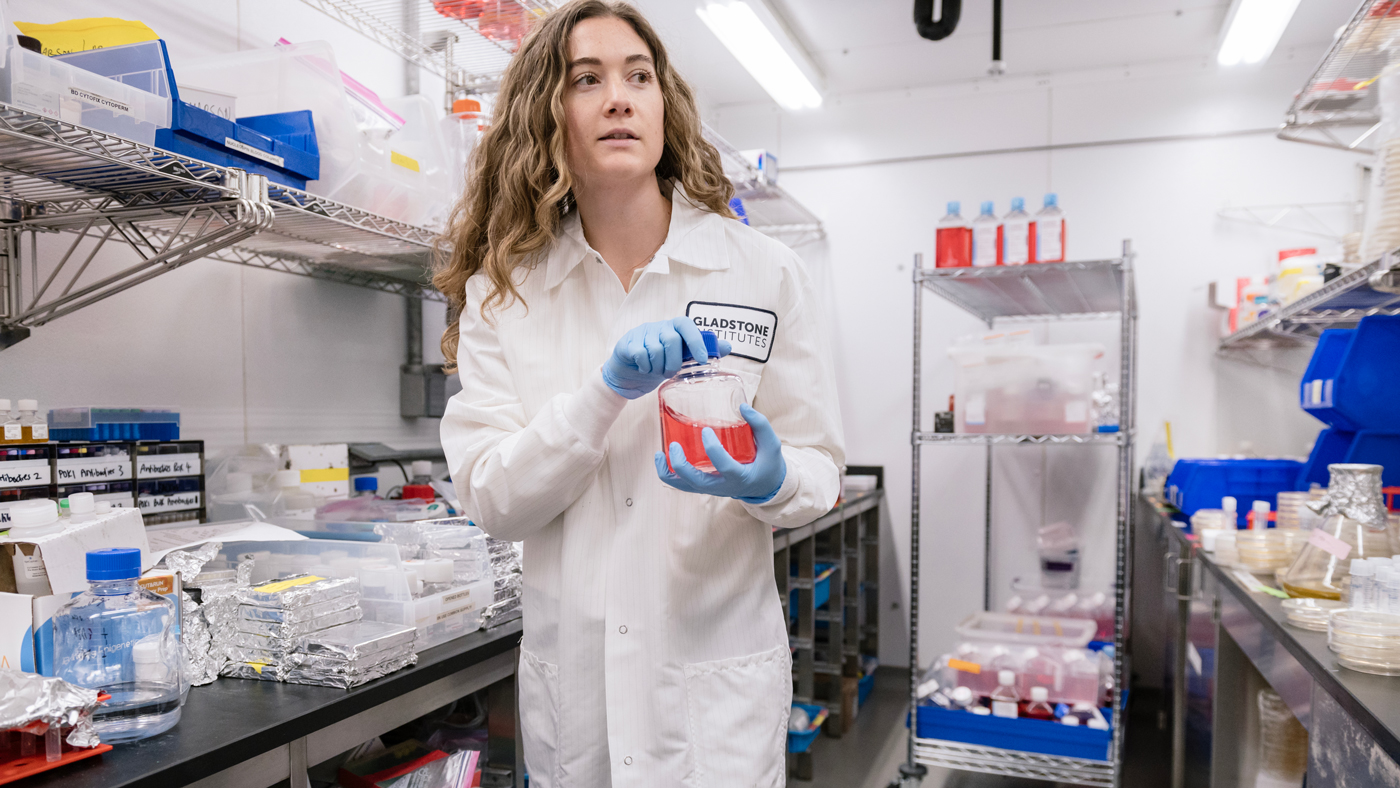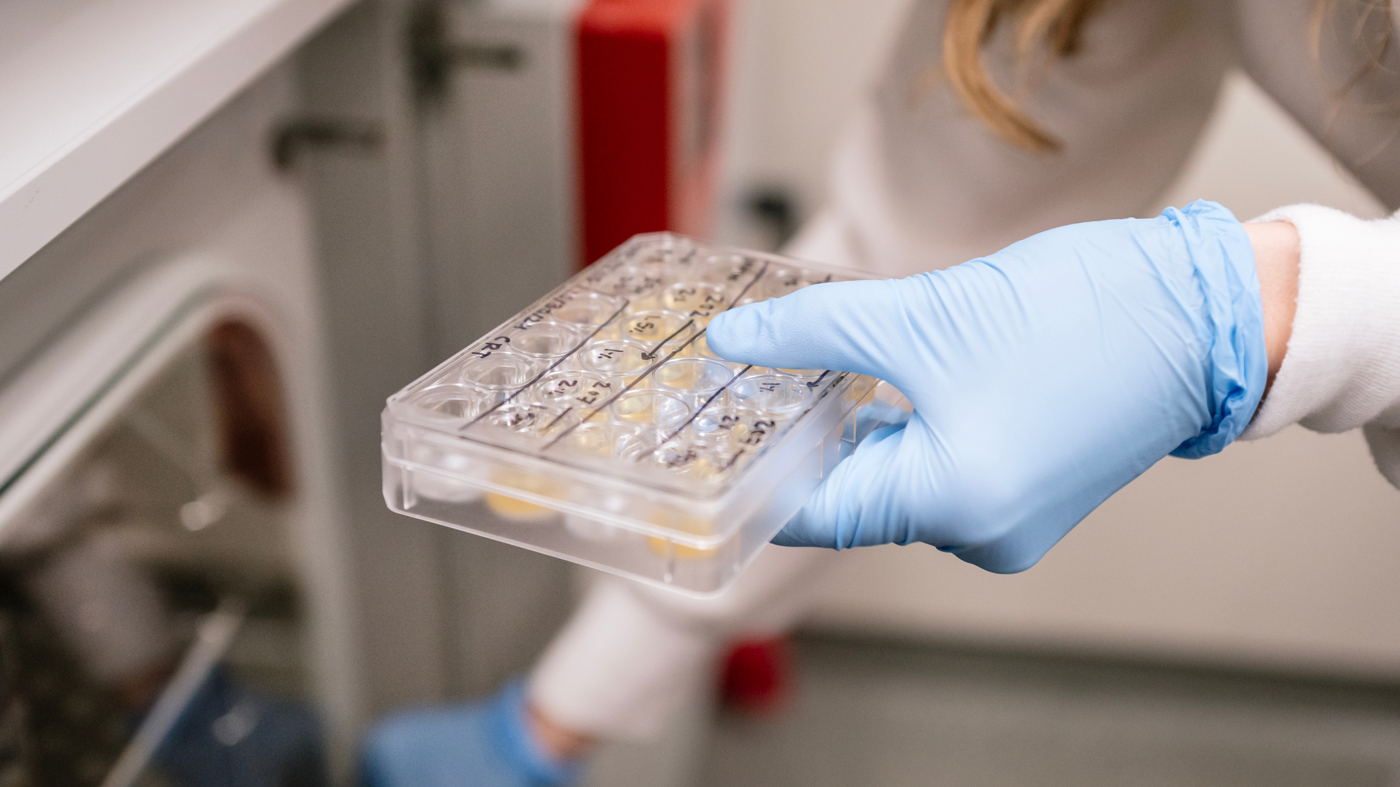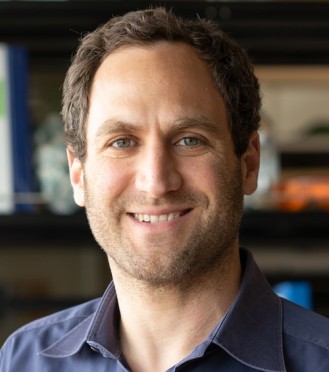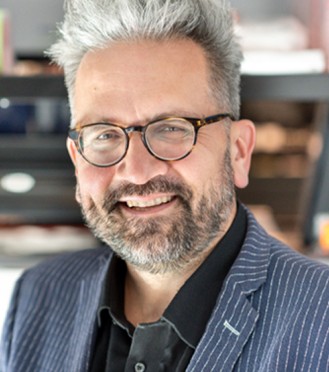Gladstone NOW: The Campaign Join Us on the Journey✕

A team of scientists—including Maya Arce, seen here—uncovered how one protein controls the behavior of immune cells, which could have applications for treating cancer and autoimmune conditions.
Cells in the immune system don’t always fight; they often rest and wait for threats, like viruses or bacteria. When such threats emerge, the cells activate to defend the body. This delicate balance between rest and activation is crucial to our health—immune cells must be poised for activation to protect against threats, but if they’re overly active, autoimmune diseases can result.
But what controls this important balance?
In a new study published in Nature, scientists from Gladstone Institutes and UC San Francisco (UCSF) focused on T cells—which serve a vital role in the immune system—and pinpointed how a network of different proteins controls rest and activation.
Remarkably, they found that a single protein called MED12 plays a central role in orchestrating when T cells rest or activate. When the team removed MED12 from T cells, the cells failed to either become fully activated or to fully rest.

Arce (left), Marson (right), and their colleagues discovered that one protein, called MED12, coordinates several functions of T cells, which play an important role in the immune system.
“We found that MED12 is a crucial switch that keeps resting cells at rest and activated cells active,” says Alex Marson, MD, PhD, director of the Gladstone-UCSF Institute of Genomic Immunology, who led the new study. “By controlling other key genes that regulate rest and activation, this one protein coordinates multiple T cell functions.”
The findings give scientists a better understanding of the basic biology of T cells and pave the way toward new therapies for the multitude of diseases in which T cell function is centrally involved.
“This new understanding of how to control rest and activation in T cells could eventually have implications for treating cancer or autoimmune disease,” says Jonathan Pritchard, PhD, a professor of genetics and biology at Stanford University who helped lead the study with Marson.
Opposing Roles of T Cells
The researchers focused on two groups of closely related T cells: conventional T cells that can help protect us from infection and cancer, and regulatory T cells that turn down unwanted immune responses and prevent autoimmunity, which happens when the body’s immune system mistakenly attacks healthy cells.
“Although these T cells have opposite roles in the immune system, they often rely on the same environmental signals to tell them when to become activated,” says Maya Arce, a graduate student in Marson’s lab and first author of the paper. “We wanted to understand the mechanisms that allow for different responses across cell types, despite their similarities.”

Arce was part of a team of researchers that used CRISPR genome editing to show how different types of T cells respond differently to similar signals from their environment.
To do so, the team looked at a common protein called IL2RA, which is abundant on the surface of activated T cells. They wanted to see how the levels of this protein change in response to various genes being turned on or off. They used CRISPR genome editing technology to systematically test thousands of genes and observe how they changed the levels of IL2RA, both in conventional and regulatory T cells.
One protein, MED12, stood out.
“It was striking to see that this same protein orchestrates the function of T cells differently across resting and activated states,” says Arce.
In conventional T cells that were resting, MED12 promoted rest and helped keep IL2RA levels low. But in regulatory T cells and in conventional T cells that were activated, the scientists found that MED12 had the opposite effect and helped turn up the levels of IL2RA.
Conducting an Orchestra of Dynamic T Cell Responses
To better understand how MED12 functions, Marson’s group teamed up with Gladstone Senior Investigator Nevan Krogan, PhD, and Affiliate Investigator Ansuman Satpathy, MD, PhD.
Together, the scientists showed that MED12 binds to large groups of proteins known to control the structure of chromatin—the packaged form of DNA inside cells. Next, the team discovered that MED12 and its associated proteins bind to different places in the genome in different T cell types and states.
“We found that by changing the chromatin structure, or the way DNA is organized, in different areas of the genome, MED12 and the other proteins can control which genes are most easily turned on in different conditions,” says Satpathy, who is also a professor in the Department of Pathology at the Stanford School of Medicine.
When the researchers removed MED12 from cells, these chromatin changes were reduced, and conventional T cells had less distinct resting and active states.

By shedding light on the basic biology of T cells, the new study could eventually help researchers engineer more effective immunotherapies.
“It was apparent that MED12 sits at the top of a hierarchy, like an orchestra conductor controlling what other genes and proteins can do,” says Krogan, who is also the director of the Quantitative Biosciences Institute at UCSF. “Without MED12, the line between rest and activation becomes blurred; the resting cells look more activated, and the activated cells look more like resting cells.”
In some cases, this dampened effect could be beneficial. The scientists showed that activated conventional T cells lacking MED12 were less likely to undergo cell death in response to high levels of stimulation—a process that often makes cancer immunotherapies less effective. The results help explain why another recent study showed that engineered T cells lacking MED12 could be more effective at targeting tumors.
“Our study provides insights into the important role of MED12 and helps explain how T cells coordinate their distinct functions,” says Marson, who is also director of the Parker Institute for Cancer Immunotherapy at Gladstone. “A deeper understanding of this mechanism could ultimately help us engineer more effective immunotherapies.”
For Media
Julie Langelier
Associate Director, Communications
415.734.5000
Email
About the Study
The paper, “Central control of dynamic gene circuits governs T cell rest and activation,” was published in the journal Nature on December 11, 2024. The authors are Maya Arce, Jennifer Umhoefer, Sivakanthan Kasinathan, Jacob Freimer, Zachary Steinhart, Mineto Ota, Anika Wadhera, Rama Dajani, Dmytro Dorovskyi, Yan Yi Chen, Qi Liu, Yuan Zhou, Danielle Swaney, Kirsten Obernier, Brian Shy, Julia Carnevale, Ansuman Satpathy, Nevan Krogan, and Alex Marson of Gladstone and UCSF; Nadia Arang and Haolin Shen of UCSF; and Minh Pham and Jonathan Pritchard of Stanford.
The work was supported by the National Science Foundation (2038436), the National Institutes of Health (R01HG008140, 2R01HG008140, K08CA273529, L30TR002983, 1K08CA252605-01, T32AR050942, U01CA260852, U54CA274502), the Astellas Foundation for Research on Metabolic Disorder, the Chugai Foundation for Innovative Drug Discovery Science, the UCSF Scholars-At-Risk Program, the Burroughs Wellcome Fund, the Lydia Preisler Shorenstein Donor Advised Fund, the Parker Institute for Cancer Immunotherapy, the Simons Foundation, the Cancer Research Institute, the Innovative Genomics Institute, the Larry L. Hillblom Foundation (2020-D-002-NET), the Northern California JDRF Center of Excellence, the Byers family, Karen Jordan, the CRISPR Cures for Cancer Initiative, the Lupus Foundation of America, the Stanford Maternal and Child Health Research Institute, and Pew Charitable Trusts.
About Gladstone Institutes
Gladstone Institutes is an independent, nonprofit life science research organization that uses visionary science and technology to overcome disease. Established in 1979, it is located in the epicenter of biomedical and technological innovation, in the Mission Bay neighborhood of San Francisco. Gladstone has created a research model that disrupts how science is done, funds big ideas, and attracts the brightest minds.
About UCSF
The University of California, San Francisco (UCSF) is exclusively focused on the health sciences and is dedicated to promoting health worldwide through advanced biomedical research, graduate-level education in the life sciences and health professions, and excellence in patient care. UCSF Health, which serves as UCSF’s primary academic medical center, includes top-ranked specialty hospitals and other clinical programs, and has affiliations throughout the Bay Area. Learn more at ucsf.edu, or see our Fact Sheet.
About the Quantitative Biosciences Institute
The Quantitative Biosciences Institute (QBI) fosters collaborations across the biomedical and the physical sciences, seeking quantitative methods to address pressing problems in biology and biomedicine. Motivated by problems of human disease, QBI is committed to investigating fundamental biological mechanisms, because ultimately solutions to many diseases have been revealed by unexpected discoveries in the basic sciences.
Support Discovery Science
Your gift to Gladstone will allow our researchers to pursue high-quality science, focus on disease, and train the next generation of scientific thought leaders.
Genomic Maps Untangle the Complex Roots of Disease
Genomic Maps Untangle the Complex Roots of Disease
Findings of the new study in Nature could streamline scientific discovery and accelerate drug development.
News Release Research (Publication) Marson Lab GenomicsSix Gladstone Scientists Named Among World’s Most Highly Cited Researchers
Six Gladstone Scientists Named Among World’s Most Highly Cited Researchers
The featured scientists include global leaders in gene editing, data science, and immunology.
Awards News Release Corces Lab Doudna Lab Marson Lab Pollard Lab Ye LabThe Genome Editing Playbook Is Different in Neurons
The Genome Editing Playbook Is Different in Neurons
The striking findings of a new study could influence how gene therapies are designed for many genetic diseases.
News Release Research (Publication) Neurological Disease Conklin Lab Doudna Lab CRISPR/Gene Editing





